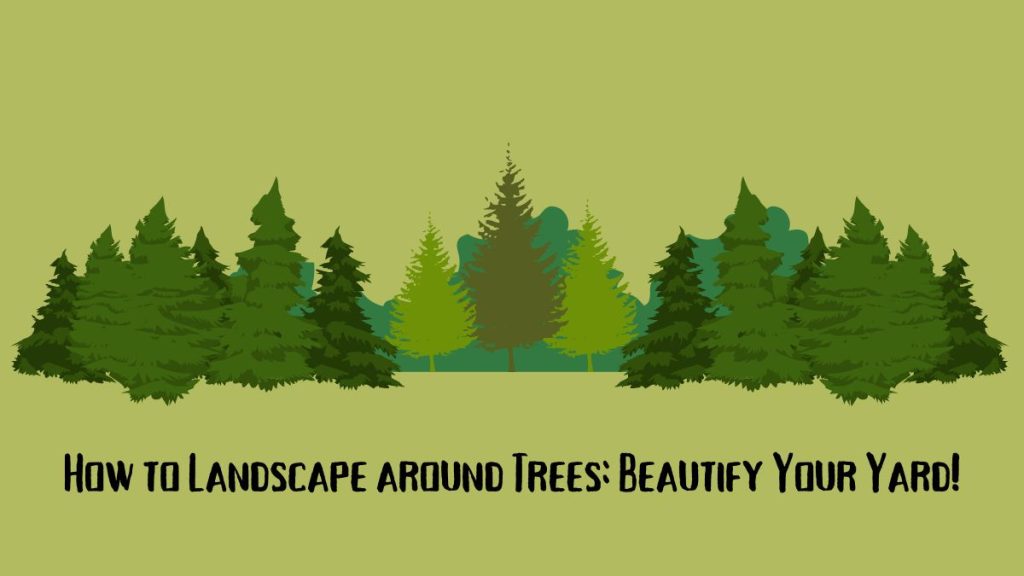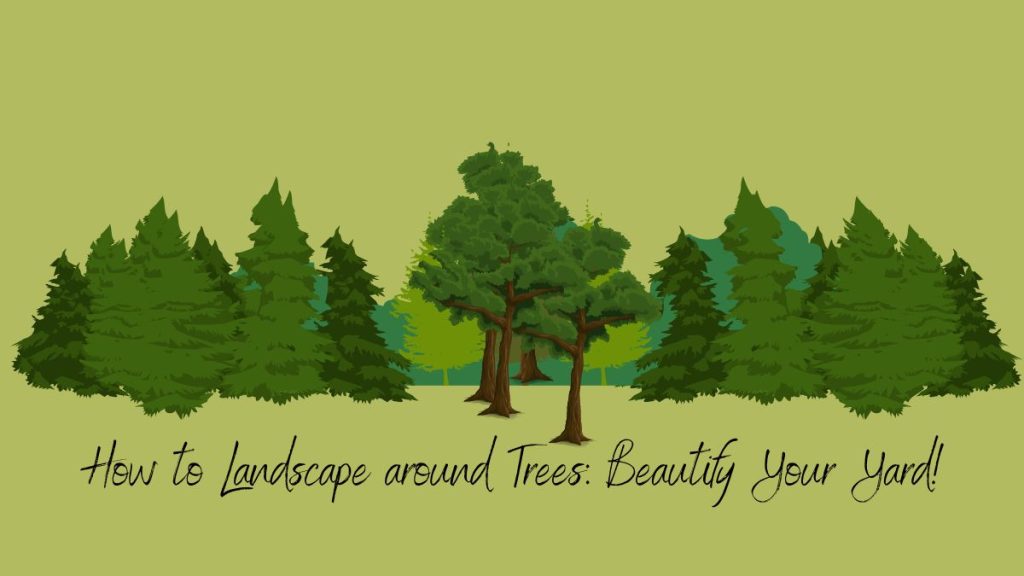To landscape around trees, use mulch to retain moisture and add borders for visual appeal. Avoid piling soil against the tree trunk.
Landscaping around trees enhances the beauty of your yard while promoting tree health. Mulch creates a protective barrier, retaining moisture and reducing weed growth. Choose organic mulch, like wood chips or bark, for best results. Borders, such as stones or bricks, add structure and define the area.
Ensure the tree roots have enough space to breathe and grow. Avoid piling soil or mulch directly against the tree trunk to prevent rot. Regular maintenance, such as weeding and replenishing mulch, keeps the landscape attractive and healthy. Proper planning and care ensure a thriving, picturesque yard.
Related Article: Benefits of Landscape Architecture: Enhance Your Space!

Related Article: Simple Landscape Design Ideas: Transform Your Yard Now!
Choosing The Right Plants
Landscaping around trees can be a rewarding project. It adds beauty and value to your garden. The key to success is selecting the right plants. This ensures harmony and growth. Explore some essential factors to consider.
Native Vs. Non-native Species
Choosing between native and non-native species is crucial. Native plants are adapted to the local climate. They require less maintenance and water. They also support local wildlife.
On the other hand, non-native plants offer more variety. They can bring unique colors and textures. Ensure they are not invasive. Invasive species can harm your tree and local ecosystem.
| Type | Benefits | Considerations |
|---|---|---|
| Native Species | Low maintenance, supports wildlife | Limited variety |
| Non-native Species | Unique aesthetics, diverse options | Risk of invasiveness |
Shade Tolerance
Shade tolerance is another vital factor. Trees create shaded areas. Not all plants thrive in the shade. Choose shade-tolerant plants for healthy growth.
Examples of shade-tolerant plants include:
- Hostas
- Ferns
- Astilbes
- Lungwort
These plants adapt well under trees. They create a lush, green environment. Proper selection ensures a thriving landscape.
Preparing The Soil
Preparing the soil around trees is crucial. It ensures healthy tree growth and beautiful landscapes. Proper soil preparation will support the trees and surrounding plants. This guide will help you get the best results.
Testing Soil Ph
Start by testing the soil pH. This tells you how acidic or alkaline the soil is. Trees need a balanced pH to thrive. Use a soil testing kit for accurate results. These kits are available at garden stores.
Follow these steps to test soil pH:
- Collect soil samples from different areas around the tree.
- Mix the samples in a clean container.
- Follow the instructions on the soil testing kit.
- Record the pH level.
Most trees prefer a pH between 6.0 and 7.0. Adjust the soil if the pH is outside this range.
Improving Soil Quality
Improving soil quality is essential for tree health. Good soil provides nutrients and supports root growth. Here are some steps to improve soil quality:
- Remove any weeds around the tree.
- Add compost to enrich the soil with organic matter.
- Use mulch to retain moisture and protect roots.
- Aerate the soil to improve air and water flow.
Adding compost is very beneficial. It adds nutrients and improves soil structure. Spread a 2-3 inch layer of compost around the tree base. Avoid piling compost against the tree trunk.
Mulching is another important step. Use wood chips, straw, or leaves as mulch. Spread mulch in a 3-4 inch layer around the tree. Keep mulch a few inches away from the trunk.
Aerating the soil helps roots breathe. Use a garden fork or aerator tool. Gently poke holes in the soil around the tree. This improves water and nutrient absorption.
Related Article: Types of Landscaping Garden: Transform Your Outdoor Space
Design Considerations
Designing a landscape around trees involves thoughtful planning. You need to consider factors like visual balance and seasonal changes. This ensures the beauty and health of the trees. Below are important design considerations to help you.
Visual Balance
Visual balance is crucial in landscape design. Symmetry or asymmetry can be used to create a pleasing look. A balanced design makes the space feel harmonious.
Use ground covers, shrubs, and flowers to complement the tree. This enhances the overall appearance. Ensure the plants don’t compete with the tree for resources.
Here are some tips for visual balance:
- Choose plants of varying heights.
- Use colors that match or contrast well.
- Place larger plants closer to the tree.
- Smaller plants can go farther away.
Seasonal Planning
Seasonal planning keeps your landscape attractive all year. Different plants bloom in different seasons. Choose plants that bloom at various times.
Consider the following when planning for seasons:
| Season | Plant Types |
|---|---|
| Spring | Bulbs, early-blooming perennials |
| Summer | Annuals, late-blooming perennials |
| Fall | Fall-blooming perennials, ornamental grasses |
| Winter | Evergreens, winter-blooming shrubs |
Regularly update the plants to keep the landscape dynamic. This ensures there is always something attractive in your yard.
Lastly, use mulch around the tree base. This helps to retain moisture and reduce weeds.
Related article: How Much Does It Cost to Landscape a Backyard: Budget Guide
Mulching Techniques
Mulching is a vital step in landscaping around trees. It helps retain moisture, control weeds, and improve soil health. Below, we explore different mulching techniques to ensure your trees thrive.
Types Of Mulch
There are various types of mulch available. Each type has its unique benefits:
- Organic Mulch: Includes wood chips, bark, straw, and compost. It improves soil structure as it decomposes.
- Inorganic Mulch: Includes stones, gravel, and landscape fabric. It provides excellent weed control and lasts longer.
Proper Mulching Methods
Proper mulching ensures your trees get the most benefits:
- Clear the Area: Remove grass and weeds around the tree base.
- Apply Mulch: Spread mulch in a circle around the tree. Keep it 2-4 inches deep.
- Leave Space: Avoid piling mulch against the tree trunk. Leave a 2-3 inch gap to prevent rot.
| Mulch Type | Benefits | Drawbacks |
|---|---|---|
| Wood Chips | Improves soil as it decomposes | Can attract insects |
| Gravel | Long-lasting and great for weed control | Does not improve soil |
Follow these steps and your trees will thank you!
Watering And Maintenance
Proper watering and maintenance are crucial for healthy trees in your landscape. This section covers efficient watering practices and essential pruning and care tips.
Efficient Watering Practices
Trees need water to grow strong and healthy. Watering deeply helps roots grow deep. Shallow watering leads to weak roots. Use a soaker hose or drip irrigation for best results.
- Water early in the morning or late in the evening.
- Avoid watering during the heat of the day.
- Apply water slowly to ensure it soaks in deeply.
| Tree Type | Watering Frequency |
|---|---|
| Young Trees | 1-2 times per week |
| Mature Trees | 1-2 times per month |
Pruning And Care
Pruning keeps trees healthy and looking good. Remove dead or diseased branches. This prevents pests and diseases. Prune in late winter or early spring for best results.
- Use clean, sharp tools for pruning.
- Cut branches at a 45-degree angle.
- Remove no more than 25% of the tree’s canopy at once.
Regular maintenance ensures tree health. Check for signs of disease or pests. Mulch around the tree base to retain moisture. Use organic mulch like wood chips or bark.
Related Article: Modern Landscaping Designs: Transform Your Outdoor Space Today

Related Article: Best Landscaping Trees: 10 Must-Have Varieties!
Protecting Tree Roots
Landscaping around trees requires careful attention to their roots. Tree roots are vital for the tree’s health. Protecting them ensures the tree thrives and remains healthy. Here are some ways to protect tree roots effectively.
Avoiding Physical Damage
Avoiding physical damage to tree roots is crucial. Do not dig or till the soil near the tree. Use hand tools instead of heavy machinery. Avoid driving vehicles over the root zone.
If you must work near the tree, use mulch to create a buffer zone. A thick layer of mulch protects the roots and retains moisture. Keep the mulch a few inches away from the tree trunk.
Root Aeration
Root aeration is essential for healthy tree roots. Compacted soil can suffocate the roots. Use a garden fork to gently loosen the soil. Ensure you do not damage the roots while doing this.
Another method is using aeration tubes. Insert tubes into the soil to allow air to reach the roots. This method is less invasive and promotes healthier roots.
| Method | Description |
|---|---|
| Avoiding Physical Damage | Use hand tools, avoid heavy machinery, and apply mulch. |
| Root Aeration | Loosen soil with a garden fork or use aeration tubes. |
Follow these tips to protect tree roots and maintain a beautiful landscape. Your trees will thrive and enhance your garden’s beauty.
To Watch Best Landscaping Around Trees Ideas and Designs>>
Related Article: Best Landscape Architecture Books to Transform Your Design Perspective
Conclusion
Creating a beautiful landscape around trees enhances your garden’s appeal. Use mulch to protect roots and retain moisture. Choose shade-tolerant plants that complement the tree’s natural beauty. Regular maintenance ensures a healthy and vibrant landscape. Follow these tips, and your trees will thrive in a stunning, well-planned garden setting.
Related Article: How Can Landscape Architecture Serve the World Today
Related Article: Low Maintenance Landscaping Ideas for Front of House: Easy Tips

Pingback: Best Landscaping Trees: 10 Must-Have Varieties! - SpaceArc
Pingback: Low Maintenance Landscaping Ideas for Front of House: Easy Tips - SpaceArc
Pingback: How Can Landscape Architecture Serve the World Today - SpaceArc
Pingback: Benefits of Landscape Architecture: Enhance Your Space! - SpaceArc
Pingback: Modern Landscaping Designs: Transform Your Outdoor Space Today - SpaceArc